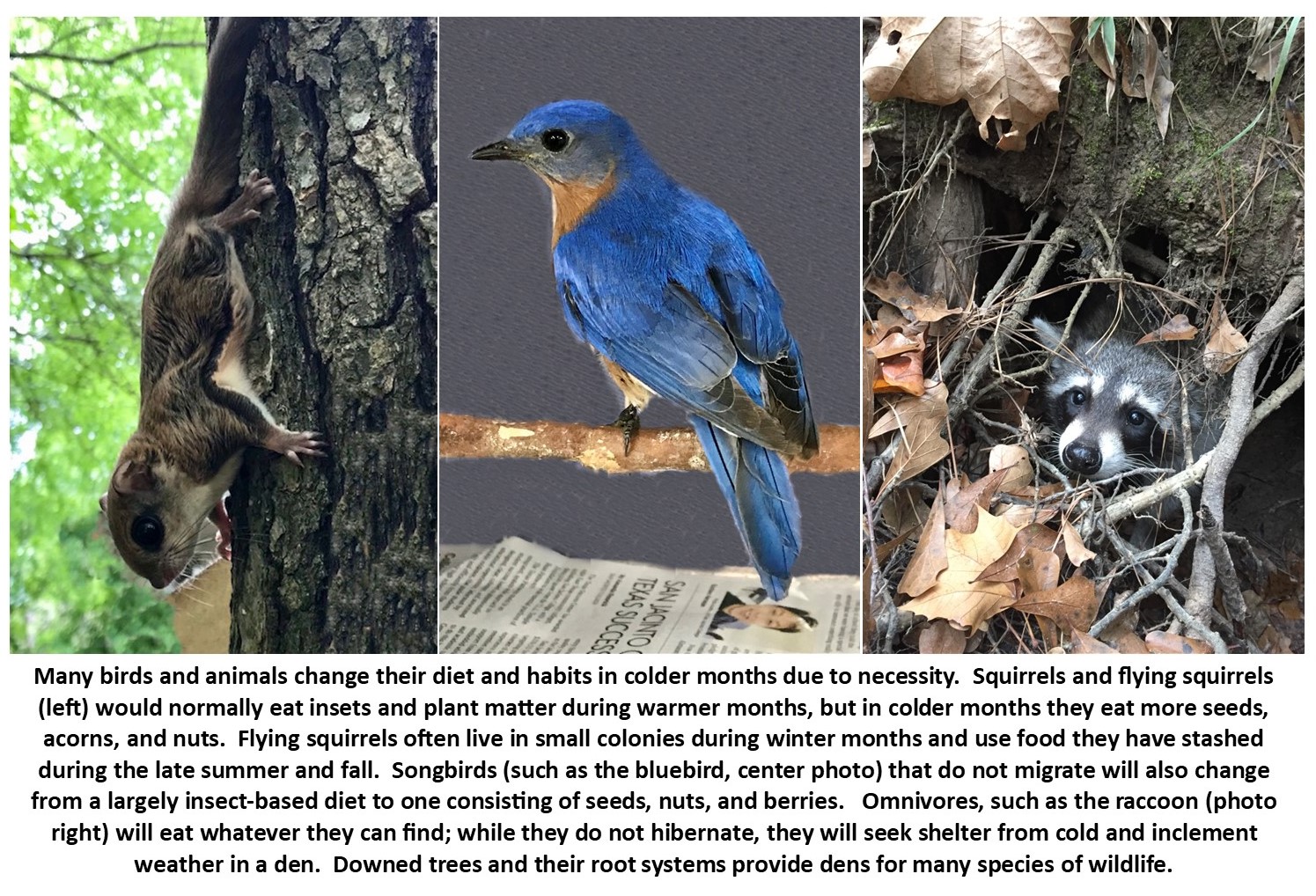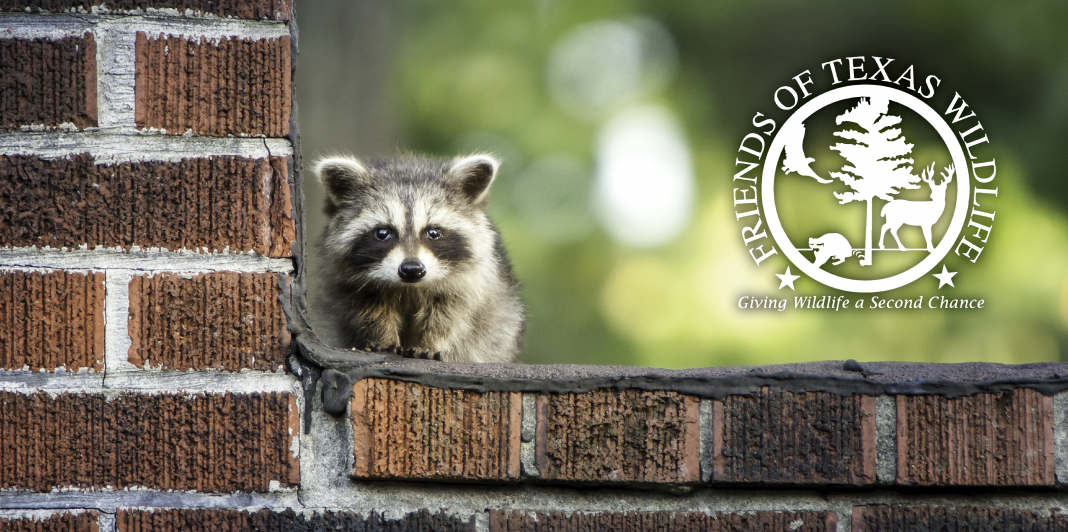Animals in Winter
We live in a part of the country where winters tend to be mild, albeit with sometimes wild swings in weather and temperatures. Due to our more temperate climate, many of our native animals do not migrate or hibernate. Therefore, it may be easy to overlook that our wildlife friends need to adapt to the seasonal temperature differences. Some adaptations are more obvious than others, while some changes are more subtle, but there is a lot going on during the cooler months.

In much colder, snowier environments, many animals hibernate. Hibernation is defined as a state of inactivity characterized by low body temperature, slow breathing and heart rate, and low metabolic rate. Further up north, many mammals hibernate, such as bears, bats, skunks, and groundhogs. Here in our part of Texas, it is not necessary for mammals to hibernate as we do not have extended periods of cold weather and snow. However, some other species of animals do need to enter a state of hibernation or, alternatively, a state of torpor. Torpor is a state of decreased physiological activity in an animal, usually due to a reduced body temperature and metabolic rate. Torpor enables animals to survive periods of reduced food availability. Torpor is a “lighter” form of hibernation, so to speak. Animals here that would enter states of hibernation or torpor would include cold-blooded animals (snakes, lizards, amphibians, turtles, tortoises) and some insects (ladybugs, certain bees). Cold-blooded animals cannot digest food adequately when their body temperatures drop too low, and for those dependent on insects for food, their food source is largely gone in colder months. For insects, the flowers and plants they depend on for food, or other insects they prey on, are also unavailable during the winter. So, while they may not hibernate for long periods of time, they will enter a state of torpor and stay in that state until the temperatures warm again. Turtles and frogs may bury themselves in mud under lakes and ponds for up to six months at a time, although here in Texas it is likely to only be for a few months. For insects, many have their life cycle end with the arrival of cold weather. However, ladybugs survive by gathering together in large clusters to hibernate. Honeybees create a winter cluster in their hive, surrounding the queen. The bees “shiver” to create an environment which retains a temperature of around 80 degrees Fahrenheit inside the hive. Since it takes a lot of energy to vibrate all day and night, the bees eat the honey they have stored away during the warmer months.

Some animals migrate to warmer climates. Anyone who has lived in our part of Texas for a while surely notices that our summer hummingbirds abandon us to head south for warmer weather. They are generally gone by the end of October, with some stragglers from further north passing through a bit later. We are in the flight path for migrating monarch butterflies as well. The bats found in our area also need to adapt in winter as they are insect eaters. Some of our bat species hibernate, often favoring the same roosts year after year, while other species migrate further south. In fall, you have no doubt heard flocks of geese and ducks migrating through our area. Many species of songbirds and raptors also either migrate through our part of Texas, or come here from further north to spend their winters here. Many birds that eat insects during other times of the year now change their diets to predominantly seeds during cooler months as that is what is more readily available. That is why if you have a backyard feeder you are likely to see more birds, and more of a variety of birds, visiting feeders during colder months.
Many animals and birds, if not most, change their diets in the cooler months due to changes in what is available. Skunks, raccoons, and opossums (all omnivores) will eat more seeds, berries, nuts, and roots since the insects, reptiles, or plant-based foods they eat during other months are largely unavailable in winter. All species of squirrels, which eat plant buds, flowers, berries, and insects during warmer months, now eat seeds, nuts, lichens, acorns, and whatever leftover berries they can find. Flying squirrels may even live in small colonies for the cooler months, sharing their stockpiles of food. Deer, which live more solitary lives the rest of the year, often herd up during winter months. Does separate in late spring to have their fawns, and stay separate from the bucks through the summer. After rut (fall mating), bucks and does will group up again for the winter months. For most of the year, they feed mainly on non-woody plants, grasses, and flowering weeds, but during winter months, they eat more fruits, nuts, acorns, and whatever leaves they can pick off of trees.
Although to the casual observer it might seem as though our wildlife friends don’t change their habits much during winter, there are a lot of adaptations to animal behavior during the colder months. As during warmer months, drinking water is still vitally important to all wildlife, so if you happen to have a bird bath, please continue to provide drinking water during the colder months. Remember though that if temperatures are forecast to be below freezing, birdbaths made from concrete, stone, or glass can crack if the water freezes. You may want to drain bird baths in advance of freezing weather, and instead provide water in shallow pans (such as the drain pans for flowerpots). Since birds are not likely to really “bathe” in colder months, they only need a shallow amount of water to drink. You can help them to stay dry and drink more easily by placing some stones in the bird bath or pan, or by placing a few sticks on the top so the birds can perch on to drink.
To learn more about what we do and view pictures of many of the animals we assist, please visit our Facebook page at https://www.facebook.com/SavingTexasWildlife. Details and specifies-specific flowcharts regarding how to help found animals can be viewed on our website at https://www.ftwl.org (click on “Help and Advice”). These charts are extremely helpful to determine if an animal truly needs rescuing or not. If you need assistance with a wildlife animal you have found, please call us at 281-259-0039 or email us at [email protected]. We offer many educational programs (including camps, birthday parties, educational presentations, and Second Saturdays). Our educational visitor’s center is open the second Saturday of each month from 10 a.m. to 2 p.m., located at 29816 Dobbin Hufsmith Road, Magnolia, Texas, so our next Second Saturday will be on December 10 ($5 per person, kids three and under are free). Coming up in 2023, we will be having lots of fun activities, such as Spring Break Camps; our 2nd annual Open House; and summer camps, so be sure to check our Facebook page and website for details.















